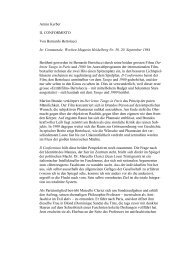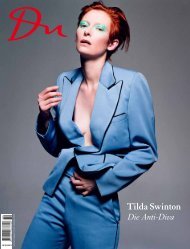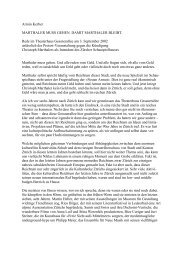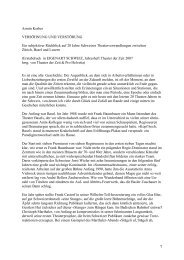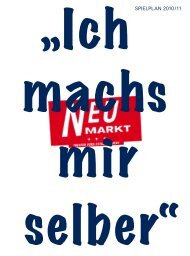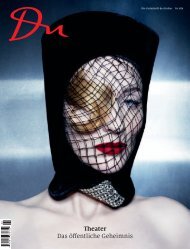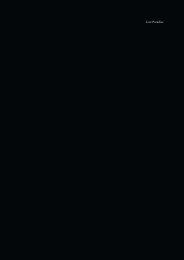Create successful ePaper yourself
Turn your PDF publications into a flip-book with our unique Google optimized e-Paper software.
<strong>Lost</strong> <strong>Paradise</strong> – “Tu n’as rien vu à Hiroshima”<br />
reply to the painter Fritz Schaefler dated April 12, 1919, in which he assures<br />
them of his loyalty and offers his services:<br />
Dear Mr Schaefler! Munich, April 12, 1919<br />
The Action Committee of Revolutionary Artists may freely dispose of my<br />
artistic powers. It is a matter of course for me to feel part of it as I have<br />
been producing for some time, and since even before the War, the kind of<br />
art that is now to be placed onto a wider public basis. My work and any<br />
of my other artistic powers and insights are at your disposal.<br />
With warmest greetings, I remain<br />
Yours Klee<br />
Paul Klee was made a member at a meeting on April 22, 1919, just five<br />
days after Reichswehrminister (Defense Minister of the German Reich)<br />
Gustav Noske had decided to send the Reich’s combat units against Munich.<br />
Klee’s revolutionary contact, however, does not appear to have gone<br />
much further than this as events began to unfold very rapidly: following<br />
the Free Corps massacres of members of the Soviet Republic’s “Red Army”<br />
and civilian by-standers, and the murder of extreme right-wing hostages<br />
by members of the Red Guards, Munich fell to the Reich’s Defense Forces<br />
in early May 1919 and the Action Committee of Revolutionary Artists<br />
dissolved after the following last communiqué:<br />
… We hereby declare that we are not the ‘representatives’ of the Munich,<br />
Bavarian or any other kind of artists who are part of the capitalist era; we<br />
are the representatives and commissioners of an idea and it is our aim to<br />
contribute in a practical manner to the creation and ideological development<br />
of a new community. We call upon the help from everyone who is<br />
of like mind. This we expect not from representatives of the old generation,<br />
as they cannot help us, but from those of our own.<br />
For the Action Committee of Revolutionary Artists: pp. Richter, Tautz.<br />
At virtually the same time in Munich, Klee created the small, worldfamous<br />
watercolour drawing of Angelus novus (New Angel).<br />
It was most likely created at so-called Werneck Castle, where Klee<br />
had found a studio in the spring of 1919, after his discharge from<br />
the military. However, it was not because of its creator that Angelus novus<br />
became a myth and key work of 20th-century art, but because of its first<br />
owner, Walter Benjamin, the German-Jewish art and cultural theorist, who<br />
acquired the work in 1921 during a visit to his friend Gersholm Scholem<br />
50



